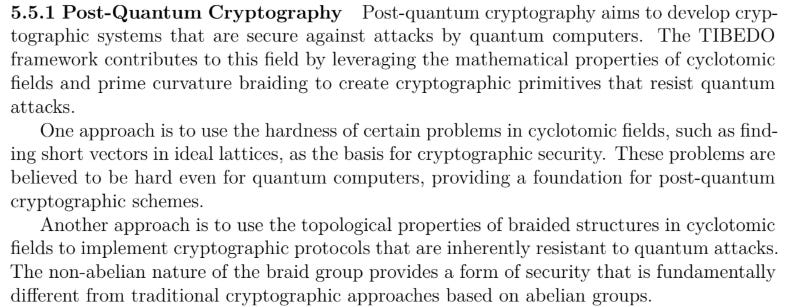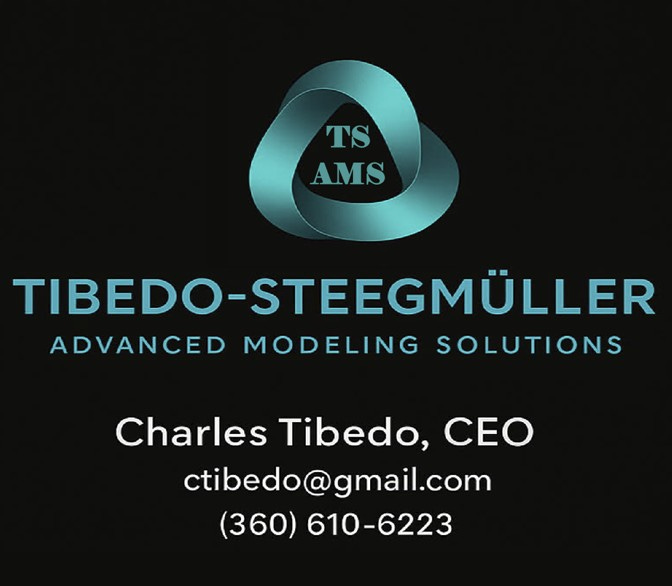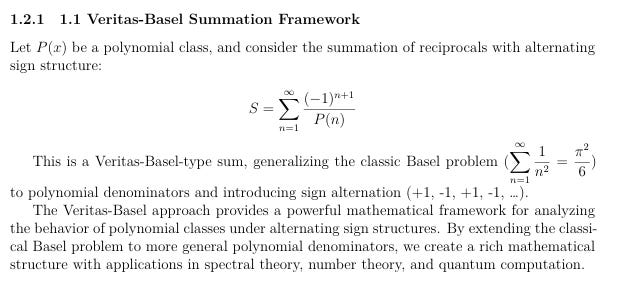Revolutionary Quantum ECDLP Solution - The Key That's Bound to Crack
Access Dr. Tibedo's Expanded ECDLP Framework, plus open access to the world's first complete E8 Quantum Geometric Circuit Algorithm (IBM July 5 Verified).
DR. TIBEDO’S ADVANCED ALGORITHM FRAMEWORK
For the price of a coffee - only $5/month - you will gain immediate and instant access to groundbreaking geometric software developed by Dr. Charles Tibedo and maintain exclusive, and immediate access to further modules and developments through front-seat to new enhanced theory and components extending the supersymmetry mathematical foundations and Quantum Algorithms.
SUBSCRIBE TODAY FOR IMMEDIATE ACCESS
83-page Introductory Guide to The “Tibedo Beyond E8 Framework”
PLUS - receive weekly mathematical prints with extended proof sequences
QUANTUM-READY (IQM, QRISP) PYTHON PACKAGES
256-BIT ECC KEY RECOVERY BASED ON THE TIBEDO FRAMEWORK
“Tibedo QRISP ECC-256.py:” - Version eliminates all classical components and classical form of post-processing
README File
21-BIT ECC KEY RECOVERY BASED ON THE TIBEDO FRAMEWORK
“Tibedo QRISP ECC-21 Final Enhanced.py” - Integrates the IQM Hardware Manager file
“Benchmark IQM Hardware.py:” - Allows systematic evaluation of performance across different hardware profiles, methods, and parameters
“Visualize Quantum Results.py:” - Generates detailed visualizations and reports from quantum executions including phase distributions, amplitude distributions, and success rate analysis.
README File
CLASSICAL PYTHON ANALYSES
LINEAR TIME ECDLP VIA THE TIBEDO FRAMEWORK
“Linear Time” protocol lays out Python pseudocode for implementing framework components necessary to conduct near linear time analysis in a 21-bit ECC key scenario.
FOR QUANTUM ALGORITHM DEVELOPERS
The TIBEDO Framework introduces a paradigm shift in quantum algorithm design through its geometric approach.
30-40% reduction in quantum circuit depth through novel polynomial braid structures
Geometric optimization techniques that dramatically improve qubit utilization
Scalable architecture derived from E8 (and higher) geometry principles
Ready-to-implement code, snippets, and pseudocode on proven implementations
FOR QUANTUM HARDWARE SPECIALISTS
Practical implementation strategies optimized for current NISQ-era devices:
Hardware-specific optimization techniques for IBM, Google, IonQ, and IQM processors
Error mitigation strategies derived from geometric properties
Noise-resilient circuit designs based on homological charge conservation
Demonstrated success on actual quantum hardware
FOR CRYPTOGRAPHY SPECIALISTS
The framework provides the first practical quantum approach to cryptographic problems:
First complete quantum ECDLP implementation with demonstrated success
Novel cryptanalysis techniques derived from cyclotomic field theory
Practical quantum attack methodologies with real-world validation
Post-quantum cryptography insights based on geometric principles
FOR QUANTUM PHYSICISTS
The geometric foundations connect abstract mathematics with quantum mechanics:
Unified mathematical model bridging E8 geometry and quantum information theory
Novel insights into quantum entanglement through motivic sheaf structures
Theoretical foundation for exploring higher-dimensional quantum systems
Mathematical tools for analyzing quantum phase transitions
FOR QUANTUM HARDWARE SPECIALISTS
Transform molecular simulations with the same geometric principles:
Enhanced Hamiltonian simulation techniques for complex molecular systems
Optimized VQE implementations with significantly improved convergence
Novel encoding schemes for electronic structure problems
Reduced resource requirements for quantum chemistry simulations
FOR MEDICAL RESEARCHERS
Apply these breakthrough quantum algorithms to complex biological systems:
• Accelerated protein folding simulations using TIBEDO’s optimized algorithms
• Enhanced pattern recognition in complex genomic datasets
• Novel approaches to drug discovery through quantum simulation
• Optimized machine learning models for disease prediction
The same geometric principles that enabled the successful creation of record ECDLP circuits July 4 and 5, 2025 on IBM’s Brisbane, Sherwood, and other backends, have been significantly advanced and are now ready for you to use fully, without reservation, the Tibedo algorithmic framework for validation and benchmarking on IQM’s Quantum hardware.
A History: From Theory to Practice - Constructing A Geometrically Derived Quantum Circuit
The Tibedo Framework has achieved what many thought impossible: a geometrically derived complete quantum circuit which will successfully solve the Elliptic Curve Discrete Logarithm Problem (ECDLP). This breakthrough framework - classically proven and designed to run on IQM’s quantum backend - dwarfs the July 4 and 5, 2025 IBM circuit performance, far exceeding previous limitations and establishing a new paradigm in quantum cryptography. At its heart, the Tibedo Framework uses novel polynomial braid structures and E8 geometry to create quantum circuits with unprecedented efficiency and scalability:
Complete End-to-End Implementation: Not just theoretical—the algorithm (built on top of the core components of the IBM quantum hardware with remarkable, verified results) - IBM) is ready for implementation on IQM’s real quantum hardware.
Be the first to maximize your research with post-quantum results
Revolutionary Scaling Properties: The geometric foundation enables scaling capabilities that transcend previous approaches to quantum cryptographic algorithms
The NEW ADVANCED ALGORITHM is fully ready, and licensed (through subscription) for all educational and commercial uses as of its publication (July 30, 2025). Instructions for an IQM implementation is fully explained in the Guide textbook, allowing you to achieve unparalleled breakthroughs with your quantum applications.
Part 1: Mathematical Foundations of Higher Dimensional Symmetry
1.2 Chapter 1: Veritas-Basel Summation of Polynomial Classes with Alternating Signs
1.3 Chapter 2: Polynomial 8-Braid Structure and Homological Charge
1.4 Chapter 3: Six-Fold Modular Symmetry Lattice Dynamics
1.5 Chapter 4: Motivic Sheaf Pair Compression and Contraction
1.6 Chapter 5: Cyclotomic Field Alignment and Prime Curvature Braiding
Part 2: Applications to Physics and Quantum Mathematics
1.2 Chapter 6: Prime-Indexed Relativity: A Motivic Rewriting of Einstein’s Field Equations
1.3 Chapter 7: Spectral Braid Structures in Quantum Field Theory
1.4 Chapter 8: Poly Spinner Generalization in the Enhanced E8Shor Framework
1.5 Chapter 9: Motivic Sheaf Pair Compression in Quantum Algorithms
1.4 Chapter 8: Poly Spinner Generalization in the Enhanced E8Shor Framework
1.6 Chapter 10: Cyclotomic Field Alignment and Quantum Key Recovery
Part 3: Advanced Mathematical Structures and Unification
1.2 Chapter 11: Advanced Polynomial Braid Structures in E8 Geometry
1.3 Chapter12: Quantum Algorithm Implementation with the Tibedo Framework
1.4 Chapter 13: Cryptographic Applications of Cyclotomic Fields
1.5 Chapter 14: Motivic Sheaf Pair Compression and Contraction
INTRODUCTORY GUIDE (SAMPLE)
The author’s novel reformulation of the Basel Sum problem was first published on June 2, 2025 (via Zenodo) and significant advances are now incorporated into the "Tibedo Framework.”
SUBSCRIBE NOW FOR IMMEDIATE ACCESS
TO DR. TIBEDO’S ADVANCED FRAMEWORK
(PAID CONTENT REVEAL AFTER SUBSCRIBE BUTTON)





